At the mill

LESSONS AND TRAINING COURSES
Courses take place throughout the year on weekends or on weekdays at the workshop.
The notebook making courses take place over a day. It is possible to create plain notebooks from loose sheets of paper. They cover the creation of the notebook block, the cardboard structure, the decoration, the sewing and/or binding... They are an opportunity to discover a traditional technique of simplified binding, the "flat back Bradel"; Japanese binding; criss-cross binding... The course participants leave with their notebook to give as a gift or to keep for themselves ! The price per day per person is 73 €.
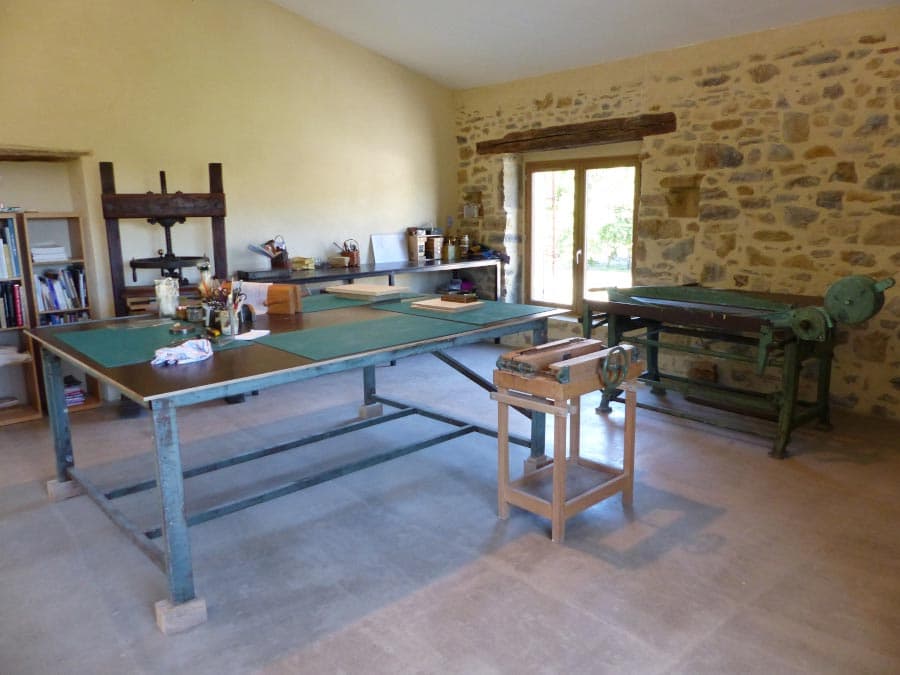
The courses are open to all: beginners, enthusiasts, savvy amateurs... A maximum of five people can attend the course at the same time which allows me to be attentive to each person's work. The course hours are 9:30-12:30 and 13:30-17:00. It is possible to have lunch on site if you bring something to eat. The workshop material is made freely available. Supplies are included in the price of the course (excluding handmade screen printed Japanese paper/handmade marbled paper and leather).
For individual courses or specific refresher courses, please contact me: 06 41 37 17 49.
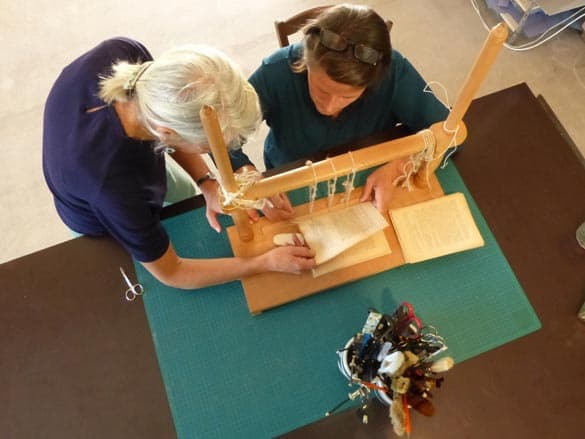
Binding lessons involve regular rather than one-off participation (attendance from once a week to once a month). They are really created "à la carte". Students come with their own books or bookbinding projects. They choose what they want to do and work at their own pace. Lessons are open to all: newbies who want to discover binding, those missing manual lessons who have a love of binding, those who are passionate about framing who want to expand their know-how, those who'll try their hand at everything who have tried out tutorials on the net, savvy amateurs who have already practiced... A maximum of five people attend classes at the same time which allows me to be attentive to each person's work. Classes can start at any time of the year. Sessions are 2 or 3 hours long. Dates and times are based on your availability and mine. It takes between 15 and 20 hours to make a book. The necessity of drying and pressing times sometimes leads us to work on several books in parallel. The workshop material is made freely available. Supplies are included in the price of the course (excluding handmade screen printed Japanese paper/handmade marbled paper and leather).
To offer a course or binding lessons to a loved one, contact me ans we will draw up gift vouchers together.
Reception of schoolchildren : any request is studied with the teacher.
« I'M NOT PRACTICAL AT ALL, CAN I TRY ANYWAY ? »
Yes of course ! What would stop you ? The first step is wanting to... Although of course, it takes patience to guide the process that can sometimes be unpredictable. And it takes precision to conduct all the operations in the right order until their completion. Each step determines the next. If the sewing of the book is done incorrectly, the spine is unbalanced. As a result, the cardboards are placed poorly and the overall appearance takes on a decidedly "misplaced" aspect ! We must overcome this. But it's not about being practical or not. If you have the desire for discovery, learning, the pleasure of taking your time, the joy of touching materials... don't hesitate.
THE MILL
The bookbindery is located in Ariège, on the edge of the Aude border, south of Toulouse, at the foot of the Pyrenees, a stone's throw from Montségur. It is housed in the building of an old mill, as the name of the street indicates, on the edge of a canal where water always flows.
The canal begins, 500 metres upstream, with the diversion of water from the river Hers in the heart of the neighboring commune of La Bastide sur l'Hers. A plan of 1784, preserved in the Departmental Archives of Ariège, shows that the canal fed, on our site, a jet workshop and a flour mill. A jet workshop is a place where jet is polished. Jet is a variety of lignite (fossilized wood) that has become very hard. Once polished, the jet turns a bright black and can be made into jewellry, beads... It was a flourishing industry in our commune of Peyrat because, in 1551, 13% of the population of the village worked there. From the middle of the nineteenth century, the jet workshop was transformed into a factory for the manufacture of horn combs, a production which was more profitable at that time.
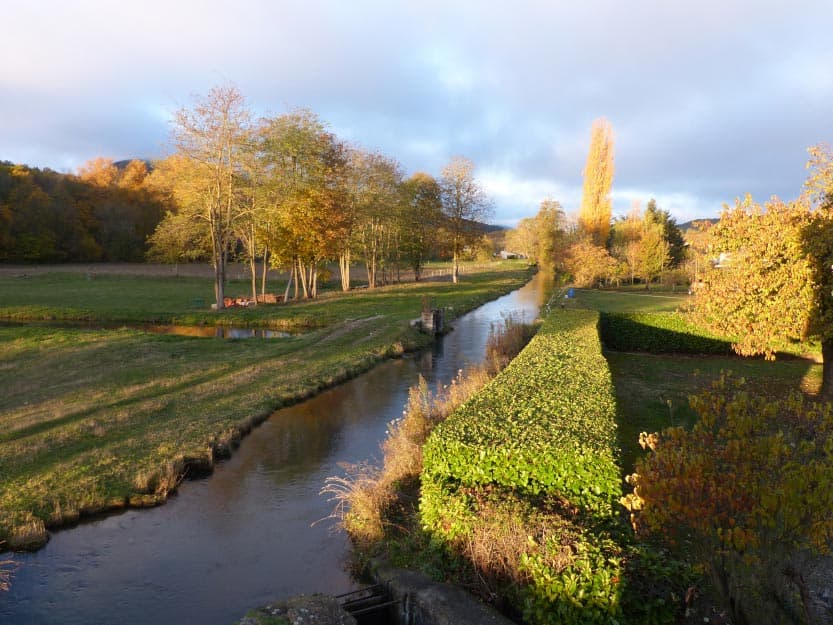 The flour mill did not change its vocation and even grew larger. On the stone frame of the door of the building that adjoins it, we can see the date of 1826 and the coat of arms of the feudal lords of Lévis. By contrast, in the 1930s, comb activity declined. A Francis water turbine was probably installed in those years for the production of electricity. Stopped in 1970, it was re-commissioned in 2008. The mill is now producing hydro-electricity again. As the waterfall is 4 metres high and the turbine flow is 1200 litres per second, the maximum power of the installation is 36 kw, which allows to produce 200,000 kwh annually (equivalent to the annual consumption of 180 people without heating). The Hers is also a river full of fish that attracts many fishermen.
The flour mill did not change its vocation and even grew larger. On the stone frame of the door of the building that adjoins it, we can see the date of 1826 and the coat of arms of the feudal lords of Lévis. By contrast, in the 1930s, comb activity declined. A Francis water turbine was probably installed in those years for the production of electricity. Stopped in 1970, it was re-commissioned in 2008. The mill is now producing hydro-electricity again. As the waterfall is 4 metres high and the turbine flow is 1200 litres per second, the maximum power of the installation is 36 kw, which allows to produce 200,000 kwh annually (equivalent to the annual consumption of 180 people without heating). The Hers is also a river full of fish that attracts many fishermen.
Exploring the surroundings
The courses and lessons are an opportunity to discover the beautiful landscapes that surround us at the foot of the Pyrenees and the rich history they carry. The famous site of Montségur, which housed a Cathar village in the 1200s, is 20 minutes from the workshop. At equal distance, you can visit the "bastide" town of Mirepoix and its many things to see and do (Monday morning markets, Apple Festival, Mima Puppet festival...). This area has had the "Pays d'Art et d'Histoire" classification since 2008 (http://www.pyreneescathares-heritage). Many nature activities are possible, particularly as the lake of Montbel is 10 minutes away, the ski resort of the Monts d'olmes 45 minutes and the Aude gorges 45 minutes. Of course, all around there are many hiking trails, cycling routes, including the old railway line which has been turned into a walking and cycling path. The nearby village of La Bastide sur l'Hers is home to a holiday village (gîte rental), a restaurant, the artisan butcher-charcutier Escot, a grocery store... It is worth stopping here to visit the Tisseyre Art of Knifemaking Workshop, classified 'Meilleur Ouvrier de France' (https://www.couteaux-tisseyre.com/). In this beautiful region of Occitania, history aficionados will find matter to satisfy their thirst for discoveries. Puivert castle is 30 minutes from the bindery, Foix Castle 40 minutes and that of Puilaurens as well as the city of Carcassonne 1 hour away. Dinosaurs will have no secret for you after a visit to Esperaza (30 minutes). The unforgettable village of Les Forges de Pyrène is one of the few opportunities to see a tilt forge in operation. Within an hour's radius, there are the caves of Mas d'azil, Lombrives and Niaux which remains an accessible cave for discovering prehistoric cave art. And in two hours you can reach Andorra or the Mediterranean Sea.
There are many accommodation possibilities in the surrounding area. Do not hesitate to contact me for more information or consult the three local tourist offices :
www.tourisme-mirepoix.com
www.ariege-pyrenees-cathares.com
www.pyreneesaudoises.com
For any request for information or booking for an course, please contact me: 06 41 37 17 49.
ABOUT ME
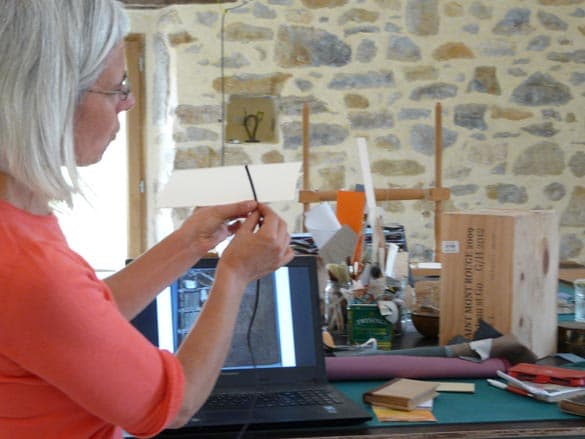 After graduating from business school and following my first professional experiences in humanitarian missions, I discovered ethnology and passed an postgraduate diploma. This led me to a publishing house for publications about the historical heritage of individual districts in different departments of France, and then on to the management of a French Ministry of Culture classification, the "Pays d'Art et d'Histoire". In parallel, I obtained a B.A. in Art History. After a decade in the service of local heritage, I undertook a professional conversion and, with the help of the Fongecif fund for individual training, I obtained the french equivalent of City & Guilds Craft Bookbinding. Followed in my early days by my tutor, Robert Campourcy in Colomiers, I created my bookbindery in the Ariège. I believe in changes and new experiences.
After graduating from business school and following my first professional experiences in humanitarian missions, I discovered ethnology and passed an postgraduate diploma. This led me to a publishing house for publications about the historical heritage of individual districts in different departments of France, and then on to the management of a French Ministry of Culture classification, the "Pays d'Art et d'Histoire". In parallel, I obtained a B.A. in Art History. After a decade in the service of local heritage, I undertook a professional conversion and, with the help of the Fongecif fund for individual training, I obtained the french equivalent of City & Guilds Craft Bookbinding. Followed in my early days by my tutor, Robert Campourcy in Colomiers, I created my bookbindery in the Ariège. I believe in changes and new experiences.
I like the idea that in the course of our life we experience different periods. After having invested a lot in intellectual fields, I wanted to learn a practical profession. With binding I was not disappointed. There are multiple universes and horizons. There is, of course, the universe of the book, that everyday companion who gives so much without asking for much. Then there is the universe of materials : papers, leathers, binding cloths mainly, but also any material that sparks the imagination of bookbinders. It is a traditional craft extremely innovative, since new ways of revisiting old techniques are constantly being invented, especially through experimentation with new materials. Contemporary artistic binding is full of imaginative and off-the-beaten-track practices...
THE BOOKBINDING PROFESSION
The activity of the bookbinder is to protect the book, beautify it, increase its service life and facilitate its consultation.
For a very long time, workshops were made up of many workers, each dedicated to a task. During the twentieth century, as in many other sectors, the number of workers per workshop decreased. Requests have become less frequent. The workshops were closed or not handed down. Since the 1980s, there has been a revival of the profession: new demands, new offers... New workshops have been created but quite differently. According to INMA, the French National Institute of Arts and Crafts, 65% of bookbinders work alone.
A BIT OF HISTORY
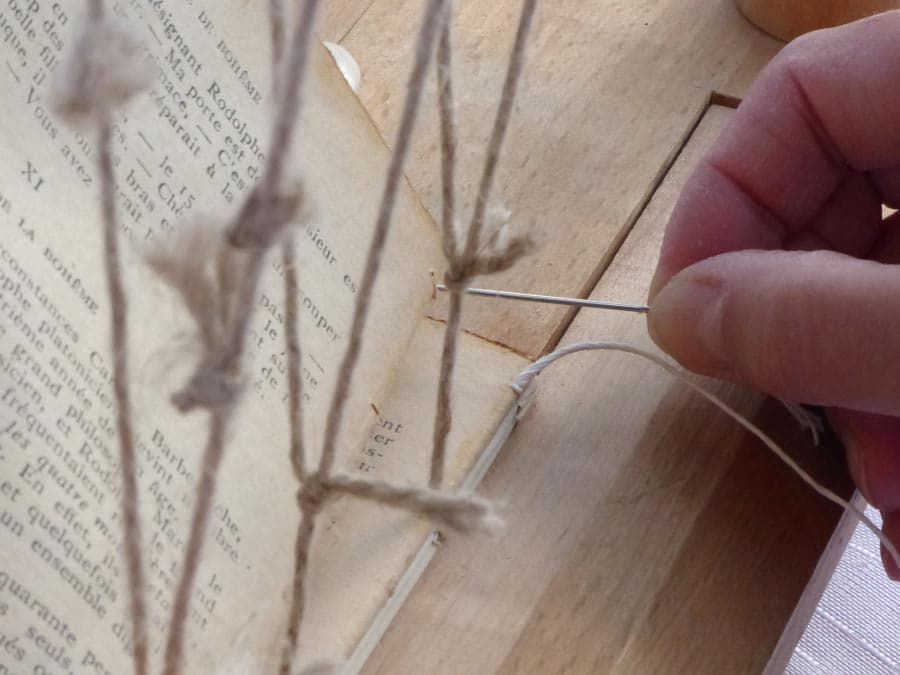
For many centuries the choice of materials and the virtuosity of gilders have constituted the aesthetics of binding. The decor of the book reflected the period in was made in and the creators choice of tools (gilding irons are "typical" of this or that period). It was not until the end of the 19th century that the bindings speak for themselves, that is, they evoke the content of the book or the personality of its author. From then on, the choice of decoration becomes infinite... That is why the end of the nineteenth and twentieth centuries were extremely fruitful for binding, allowing experimentation with incongruous a priori materials, blends of colours and new materials and "exotic" techniques. They allowed us to revisit the ways of doing things and take a few steps aside... Even nowadays, new binding techniques are being invented and tested.